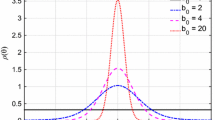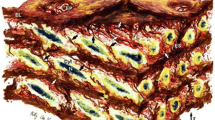Abstract
Through mechanobiological control of the extracellular matrix, and hence local stiffness, smooth muscle cells of the media and fibroblasts of the adventitia play important roles in arterial homeostasis, including adaptations to altered hemodynamics, injury, and disease. We present a new approach to model arterial wall mechanics that seeks to define better the mechanical environments of the media and adventitia while avoiding the common prescription of a traction-free reference configuration. Specifically, we employ the concept of constituent-specific deposition stretches from the growth and remodeling literature and define a homeostatic state at physiologic pressure and axial stretch that serves as a convenient biologically and clinically relevant reference configuration. Information from histology and multiphoton imaging is then used to prescribe structurally motivated constitutive relations for a bi-layered model of the wall. The utility of this approach is demonstrated by describing in vitro measured biaxial pressure–diameter and axial force–length responses of murine carotid arteries and predicting the associated intact and radially cut traction-free configurations. The latter provides a unique validation while confirming that this constrained mixture approach naturally recovers estimates of residual stresses, which are fundamental to wall mechanics, without the usual need to prescribe an opening angle that is only defined conveniently on cylindrical geometries and cannot be measured in vivo. Among other findings, the model suggests that medial and adventitial stresses can be nearly uniform at physiologic loads, albeit at separate levels, and that the adventitia bears increasingly more load at supra-physiologic pressures while protecting the media from excessive stresses.







Similar content being viewed by others
References
Agianniotis, A., A. Rachev, and N. Stergiopulos. Active axial stress in mouse aorta. J. Biomech. 45:1924–1927, 2012.
Alford, P. W., J. D. Humphrey, and L. A. Taber. Growth and remodeling in a thick-walled artery model: effects of spatial variations in wall constituents. Biomech. Model. Mechanobiol. 7:245–262, 2008.
Bersi, M. R., M. J. Collins, E. Wilson, and J. D. Humphrey. Disparate changes in the mechanical properties of murine carotid arteries and aorta in response to chronic infusion of angiotensin-II. Int. J. Adv. Eng. Sci. Appl. Math. 4:228–240, 2012.
Brankov, G., A. I. Rachev, and S. Stoychev. Mechanics of biological solid. In: Proceedings of the Euromech Colloquium, edited by G. Brankov. Varna, Bulgaria: Bulgarian Academy of Sciences, 1975, pp. 71–78.
Cardamone, L., A. Valentin, J. F. Eberth, and J. D. Humphrey. Origin of axial prestretch and residual stress in arteries. Biomech. Model. Mechanobiol. 8:431–446, 2009.
Chiquet, M., L. Gelman, R. Lutz, and S. Maier. From mechanotransduction to extracellular matrix gene expression in fibroblasts. Biochim. Biophys. Acta 1793:911–920, 2009.
Chiu, J. J., and S. Chien. Effects of disturbed flow on vascular endothelium: pathophysiological basis and clinical perspectives. Physiol. Rev. 91:327–387, 2011.
Chuong, C. J., and Y. C. Fung. On residual stresses in arteries. J. Biomech. Eng. 108:189–192, 1986.
Davis, E. C. Elastic lamina growth in the developing mouse aorta. J. Histochem. Cytochem. 43:1115–1123, 1995.
Dingemans, K. P., P. Teeling, J. H. Lagendijk, and A. E. Becker. Extracellular matrix of the human aortic media: an ultrastructural histochemical and immunohistochemical study of the adult aortic media. Anat. Rec. 258:1–14, 2000.
Dorrington, K. L., and N. G. McCrum. Elastin as a rubber. Biopolymers 16:1201–1222, 1977.
Eberth, J. F., V. C. Gresham, A. K. Reddy, N. Popovic, E. Wilson, and J. D. Humphrey. Importance of pulsatility in hypertensive carotid artery growth and remodeling. J. Hypertens. 27:2010–2021, 2009.
Eberth, J. F., N. Popovic, V. C. Gresham, E. Wilson, and J. D. Humphrey. Time course of carotid artery growth and remodeling in response to altered pulsatility. Am. J. Physiol. Heart Circ. Physiol. 299:H1875–H1883, 2010.
Ferruzzi, J., M. R. Bersi, and J. D. Humphrey. Biomechanical phenotyping of central arteries in health and disease: advantages of and methods for murine models. Ann. Biomed. Eng. 41:1311–1330, 2013.
Ferruzzi, J., M. J. Collins, A. T. Yeh, and J. D. Humphrey. Mechanical assessment of elastin integrity in fibrillin-1-deficient carotid arteries: implications for Marfan syndrome. Cardiovasc. Res. 92:287–295, 2011.
Fonck, E., G. Prodhom, S. Roy, L. Augsburger, D. A. Rufenacht, and N. Stergiopulos. Effect of elastin degradation on carotid wall mechanics as assessed by a constituent-based biomechanical model. Am. J. Physiol. Heart Circ. Physiol. 292:H2754–H2763, 2007.
Forte, A., A. Della Corte, M. De Feo, F. Cerasuolo, and M. Cipollaro. Role of myofibroblasts in vascular remodelling: focus on restenosis and aneurysm. Cardiovasc. Res. 88:395–405, 2010.
Gleason, R. L., S. P. Gray, E. Wilson, and J. D. Humphrey. A multiaxial computer-controlled organ culture and biomechanical device for mouse carotid arteries. J. Biomech. Eng. 126:787–795, 2004.
Greenwald, S. E., J. E. Moore, Jr., A. Rachev, T. P. Kane, and J. J. Meister. Experimental investigation of the distribution of residual strains in the artery wall. J. Biomech. Eng. 119:438–444, 1997.
Holzapfel, G. A., and T. C. Gasser. Computational stress-deformation analysis of arterial walls including high-pressure response. Int. J. Cardiol. 116:78–85, 2007.
Holzapfel, G. A., T. C. Gasser, and R. W. Ogden. A new constitutive framework for arterial wall mechanics and a comparative study of material models. J. Elast. 61:1–48, 2000.
Holzapfel, G. A., T. C. Gasser, and R. W. Ogden. Comparison of a multi-layer structural model for arterial walls with a Fung-type model, and issues of material stability. J. Biomech. Eng. 126:264–275, 2004.
Holzapfel, G. A., and R. W. Ogden. Constitutive modelling of arteries. Proc. R. Soc. A 466:1551–1597, 2010.
Humphrey, J. D. Mechanics of the arterial wall: review and directions. Crit. Rev. Biomed. Eng. 23:1–162, 1995.
Humphrey, J. D. Cardiovascular Solid Mechanics: Cells, Tissues, and Organs. New York: Springer, 757 pp, 2002.
Humphrey, J. D. Vascular adaptation and mechanical homeostasis at tissue, cellular, and sub-cellular levels. Cell Biochem. Biophys. 50:53–78, 2008.
Humphrey, J. D., and K. R. Rajagopal. A constrained mixture model for growth and remodeling of soft tissues. Math. Models Methods Appl. Sci. 12:407–430, 2002.
Humphrey, J. D., and C. A. Taylor. Intracranial and abdominal aortic aneurysms: similarities, differences, and need for a new class of computational models. Annu. Rev. Biomed. Eng. 10:221–246, 2008.
Karsaj, I., J. Soric, and J. D. Humphrey. A 3-D framework for arterial growth and remodeling in response to altered hemodynamics. Int. J. Eng. Sci. 48:1357–1372, 2010.
Langille, B. L. Arterial remodeling: relation to hemodynamics. Can. J. Physiol. Pharmacol. 74:834–841, 1996.
Lanir, Y. A structural theory for the homogeneous biaxial stress–strain relationships in flat collagenous tissues. J. Biomech. 12:423–436, 1979.
Li, C., and Q. Xu. Mechanical stress-initiated signal transduction in vascular smooth muscle cells in vitro and in vivo. Cell. Signal. 19:881–891, 2007.
Martufi, G., and T. C. Gasser. A constitutive model for vascular tissue that integrates fibril, fiber and continuum levels with application to the isotropic and passive properties of the infrarenal aorta. J. Biomech. 44:2544–2550, 2011.
McGrath, J. C., C. Deighan, A. M. Briones, M. M. Shafaroudi, M. McBride, J. Adler, S. M. Arribas, E. Vila, and C. J. Daly. New aspects of vascular remodelling: the involvement of all vascular cell types. Exp. Physiol. 90:469–475, 2005.
Nevo, E., and Y. Lanir. Structural finite deformation model of the left ventricle during diastole and systole. J. Biomech. Eng. 111:342–349, 1989.
Rachev, A. Theoretical study of the effect of stress-dependent remodeling on arterial geometry under hypertensive conditions. J. Biomech. 30:819–827, 1997.
Roach, M. R., and A. C. Burton. The reason for the shape of the distensibility curves of arteries. Can. J. Biochem. Physiol. 35:681–690, 1957.
Roy, S., P. Silacci, and N. Stergiopulos. Biomechanical proprieties of decellularized porcine common carotid arteries. Am. J. Physiol. Heart Circ. Physiol. 289:H1567–H1576, 2005.
Schrauwen, J. T. C., A. Vilanova, R. Rezakhaniha, N. Stergiopulos, F. N. van de Vosse, and P. H. M. Bovendeerd. A method for the quantification of the pressure dependent 3D collagen configuration in the arterial adventitia. J. Struct. Biol. 180:335–342, 2012.
Sommer, G., and G. A. Holzapfel. 3D constitutive modeling of the biaxial mechanical response of intact and layer-dissected human carotid arteries. J. Mech. Behav. Biomed. Mater. 5:116–128, 2012.
Taber, L. A., and J. D. Humphrey. Stress-modulated growth, residual stress, and vascular heterogeneity. J. Biomech. Eng. 123:528–535, 2001.
Tieu, B. C., X. Ju, C. Lee, H. Sun, W. Lejeune, A. R. Iii, A. R. Brasier, and R. G. Tilton. Aortic adventitial fibroblasts participate in angiotensin-induced vascular wall inflammation and remodeling. J. Vasc. Res. 48:261–272, 2010.
Tulis, D. A. Histological and morphometric analyses for rat carotid balloon injury model. Methods Mol. Med. 139:31–66, 2007.
Valentín, A., L. Cardamone, S. Baek, and J. D. Humphrey. Complementary vasoactivity and matrix remodelling in arterial adaptations to altered flow and pressure. J. R. Soc. Interface 6:293–306, 2009.
Vito, R. P., and S. A. Dixon. Blood vessel constitutive models-1995–2002. Annu. Rev. Biomed. Eng. 5:413–439, 2003.
von Maltzahn, W. W., D. Besdo, and W. Wiemer. Elastic properties of arteries: a nonlinear two-layer cylindrical model. J. Biomech. 14:389–397, 1981.
von Maltzahn, W. W., R. G. Warriyar, and W. F. Keitzer. Experimental measurements of elastic properties of media and adventitia of bovine carotid arteries. J. Biomech. 17:839–847, 1984.
Wagner, H. P., and J. D. Humphrey. Differential passive and active biaxial mechanical behaviors of muscular and elastic arteries: basilar versus common carotid. J. Biomech. Eng. 133:0510091–05100910, 2011.
Wan, W., H. Yanagisawa, and R. L. Gleason, Jr.. Biomechanical and microstructural properties of common carotid arteries from fibulin-5 null mice. Ann. Biomed. Eng. 38:3605–3617, 2010.
Wight, T. N. Cell biology of arterial proteoglycans. Arterioscler. Thromb. Vasc. Biol. 9:1–20, 1989.
Wilber, J. P., and J. R. Walton. The convexity properties of a class of constitutive models for biological soft issues. Math. Mech. Solids 7:217–235, 2002.
Wilson, J. S., S. Baek, and J. D. Humphrey. Importance of initial aortic properties on the evolving regional anisotropy, stiffness and wall thickness of human abdominal aortic aneurysms. J. R. Soc. Interface 9:2047–2058, 2012.
Zeller, P. J., and T. C. Skalak. Contribution of individual structural components in determining the zero-stress state in small arteries. J. Vasc. Res. 35:8–17, 1998.
Acknowledgments
We thank Matt Bersi (Yale University) for providing the codes for histological analysis (cf. Fig. 2). This work was supported, in part, by grants from the NIH (HL086418 and HL105297), the National Marfan Foundation, the Natural Sciences and Engineering Research Council of Canada (NSERC Discovery Program and NSERC CREATE Training Program for Biomedical Engineers for the 21st century), and the Werner Graupe International Fellowship in Engineering.
Conflict of interest
None.
Author information
Authors and Affiliations
Corresponding author
Additional information
Associate Editor Nathalie Virag oversaw the review of this article.
Rights and permissions
About this article
Cite this article
Bellini, C., Ferruzzi, J., Roccabianca, S. et al. A Microstructurally Motivated Model of Arterial Wall Mechanics with Mechanobiological Implications. Ann Biomed Eng 42, 488–502 (2014). https://doi.org/10.1007/s10439-013-0928-x
Received:
Accepted:
Published:
Issue Date:
DOI: https://doi.org/10.1007/s10439-013-0928-x




